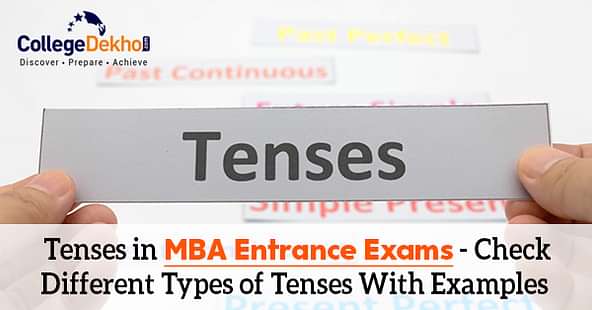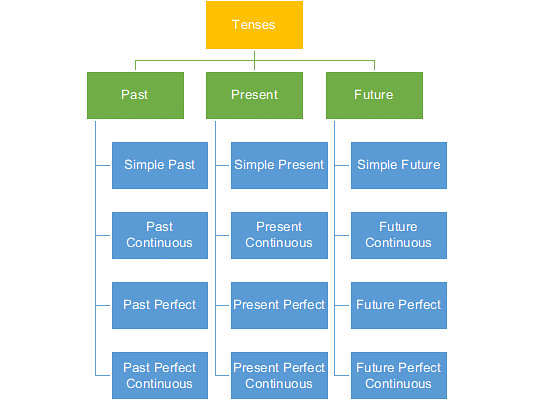Tenses are used to convey the sense of time in a sentence and they are one of the most important parts of the English Language. Know all about the different types of tenses in this article and understand how they are used in a sentence.

English is one of the main sections of every MBA entrance exam in India. No matter which MBA exam you appear for, good knowledge of English will be required to crack the exam and get a seat in a good MBA college in India . One important topic of English for MBA entrance exams, that you must have control over to get good marks, is Tenses.
What are Tenses?
Tenses are an important part of English grammar. They are used to indicate the time when an action took place. Knowing tenses is essential when framing sentences in English. While the basics of tenses are relatively simple, they can build up to be a complex topic. Hence, a student studying tenses must ensure that they have a strong foundational knowledge before they move on to the complex topics in this subject.
Tenses in MBA Entrance Exams
Since Tenses form one of the basic chapters of English, they are very important when preparing for MBA entrance exams . From questions based on sentence correction to Cloze Tests to Reading Comprehension, Tenses play a vital role in helping the student stay grammatically correct and solve Verbal Ability questions in MBA entrance exams. Even if the question might not be directly related to the use of Tenses, students may lose marks if they comprehend it incorrectly due to a wrong knowledge of the topic. Hence, it is very important for an MBA aspirant to carefully study not only the theory but also the practical use of Tenses. A student should be able to correctly identify the Tense of a sentence and spot any mistakes in its usage.
Types of Tenses
Tenses are used to convey the sense of time. They are broadly classified into the following three types.
Past Tense | Present Tense | Future Tense |
|---|
There are sub-classifications for each of these types of tenses. Hence, there are a total of 12 basic classifications of tenses in the English Language. These are as follows.

Classification of Tenses | Past | Present | Future |
|---|---|---|---|
Simple/ Indefinite | Simple Past/ Past Indefinite | Simple Present/ Present Indefinite | Simple Future/ Future Indefinite |
Continuous | Past Continuous | Present Continuous | Future Continuous |
Perfect | Past Perfect | Present Perfect | Future Perfect |
Perfect Continuous | Past Perfect Continuous | Present Perfect Continuous | Future Perfect Continuous |
These are the 12 basic classifications of tenses in the English language. Now, let us understand each of these classifications one by one with examples.
Simple/ Indefinite Tense
Indefinite Tenses, as the name suggests, are the types of tenses that do not have any defined boundaries. They do not indicate whether an action has been completed or if it is ongoing. Indefinite tenses are more commonly referred to as Simple Tenses. Indefinite Tenses are used to indicate facts or habits. These are of three types - Simple Past, Simple Present and Simple Future. Each of these has been explained below.
Simple Past Tense
Simple past tense is used to indicate any activity that started in the past and ended in the past. Past habits are also indicated using this form of Tenses. The following table contains some examples of the Simple Past Tense.
Affirmative | Negative | Interrogative |
|---|---|---|
I studied. You ran. She called. He jumped. They sang. We walked. It started. | I did not study. You did not run. She did not call. He did not jump. They did not sing. We did not walk. It did not start. | Did I study? Did you run? Did she call? Did he jump? Did they sing? Did we walk? Did it start? |
Simple Present Tense
Simple Present Tense is a bit more complicated than others. Apart from denoting actions that happen in the present, it also has a number of other uses such as to indicate habits, facts or universal truths etc. Interesting use of Simple Present Tense is that it can be used to indicate future activities that are scheduled to happen. Let us first take a look at some examples of this tense and then we will move on to its uses.
Affirmative | Negative | Interrogative |
|---|---|---|
I write. You eat. He stands. She sits. They work. We rest. It falls. | I do not write. You do not eat. He does not stand. She does not sit. They do not work. We do not rest. It does not fall. | Do I write? Do you eat? Does he stand? Does she sit? Do they work? Do we rest? Does it fall? |
Use of Simple Present Tense
As stated above, what makes simple present an interesting form of Tenses is that it has varied uses and can even be used to indicate future activities. Here are the uses of Simple Present Tense with examples.
Used For | Examples |
|---|---|
Facts or Universal Truths | The Sun rises in the East on Earth. Water is colourless, odourless and tasteless. Man is mortal. |
Habits | She goes for a morning walk every day. He exercises regularly to stay fit. I practice solving a Mock Test every Saturday. |
Scheduled Activities | The first shift of the exam ends at 12 noon. The bus leaves for the centre at 3 pm. |
Making News/ Commentary engaging | The batsman hit the bouncer over the Covers for six. Messi passes the ball to Ronaldo. |
Simple Future Tense
Any event that will happen in the future is denoted using Simple Future Tense. Here are some examples to help you understand.
Affirmative | Negative | Interrogative |
|---|---|---|
I will sleep. You will rest. He will drink water. She will drive. They will qualify. We will work hard. It will be all right. | I will not sleep. You will not rest. He will not drink water. She will not drive. They will not qualify. We will not work hard. It will not be all right. | Will I sleep? Will you rest? Will he drink water? Will she drive? Will they qualify? Will we work hard? Will it be all right? |
Continuous Tense
Continuous Tenses are used to denote any activities or events that are, were or will be ongoing at any point of time. They are denoted with the verb + ing form and are also very recognizable. Before moving on to exploring the types of Continuous Tenses, candidates must note that there are some verbs that can be used in the verb + ing format while others cannot. These are called Dynamic and Stative Verbs respective. Here is a quick explanation of both.
Dynamic Verbs | Stative Verbs |
|---|---|
|
Examples
|
Dual Verbs: There are some verbs that can be Dynamic or Stative based on their usage. They may be used in the ing format in some cases while not in others. Here are some examples.
Examples Dual Verbs | |
|---|---|
Dynamic Use | Stative Use |
|
|
Dynamic and Stative Verbs are in itself a vast topic, which we may approach in detail in future articles. However, for now, lets us move on the types of continuous tenses.
Past Continuous Tense
These are used to denote an actions that were taking place at any point in the past. When using the past continuous tense, the time of the action is either clear to the listener or it is made apparent in the sentence. The following format must be kept in mind when creating a sentence in past continuous tense.
Subject + | Auxiliary Verb + | Main Verb + | Object |
|---|---|---|---|
was/ were | participle form |
Some examples of Past Continuous Tense have been provided below.
Affirmative | Negative | Interrogative |
|---|---|---|
I was taking a coffee break after lunch. You were trying to finish the article at noon. He was preparing a presentation. She was working on her singing last night. We were driving through the streets at night. They were playing video games. It was going fine. | I was not taking a coffee break after lunch. You were not trying to finish the article at noon. He was not preparing the presentation. She was not working on her singing last night. We were not driving through the streets at night. They were not playing video games. It was not going fine. | Was I taking a coffee break after lunch? Were you trying to finish the article at noon? Was he preparing the presentation? Was she working on her singing last night? What were you doing at night? Were they playing video games? Was it going to be fine? |
Present Continuous Tense
Present Continuous Tense denote activities that are ongoing. It also uses the ing form of verbs. The structure of a sentence in Present Continuous Tense is as follows.
Subject + | auxiliary verb + | main verb + | object |
|---|---|---|---|
is/ am/ are | present participle |
Some examples of Present Continuous Tense can be found in the following table.
Affirmative | Negative | Interrogative |
|---|---|---|
I am speaking. You are playing football. He is dancing. She is staying at my house. We are enjoying the party. They are coming. It is moving. | I am not speaking. You are not playing football. They are not dancing. She is not staying at my house We are not enjoying the party. They are not coming. It is not moving. | Am I speaking? Are you playing football? Is he dancing? Is she staying at my house? Are they coming? Are we enjoying the party? Is it moving? |
Future Continuous Tense
The Future Continuous Tense is used to indicate activities that will be happening at any point in the future. When using the Future Continuous Tense, the point at which the activity will be occurring should be mentioned in the sentence or obvious to the listener. Given below is the structure of a Future Continuous Tense.
Subject + | auxiliary verb + | main verb + | object |
|---|---|---|---|
will/ shall + be | present participle form |
Some examples of Future Continuous Tenses have been shared below.
Affirmative | Negative | Interrogative |
|---|---|---|
I will be running in the marathon tomorrow. You will be working in the afternoon tomorrow. He will be having tea with me at 5 pm. She will be using the computer in the evening. We will be going to the concert tonight. They will be practising math problems after dinner. | I will not be running in the marathon tomorrow. You will not be working in the afternoon tomorrow. He will not be having tea with me at 5 pm. She will not be using the computer in the evening. We will not be going to the concert tonight. They will not be practising math problems after dinner. | Will I be running in the marathon tomorrow? Will you be working in the afternoon tomorrow? Will he be having tea with me at 5 pm? Will she be using the computer in the evening? Will we be going to the concert tonight? Will they be practising math problems after dinner? |
Notice how the sentence formation changes when switching to negative and interrogative forms.
Perfect Tense
Perfect Tenses indicate activities that have been completed. Based on when the activity is completed, different types of perfect tenses (past, present or future) may be used in the sentence. Perfect tenses are often identifiable with the use of has/ had/ have along with the verb. Given below is a basic way to identify which types of perfect tense will be used based on when an activity started and when it ended or wil end.
Action Starts | Action Ends | |
|---|---|---|
Past Perfect | in the past | in the past |
Present Perfect | in the past | at the time of speaking/ present |
Future Perfect | any point of time | in the future |
Now, let us explore each of the different types of perfect tenses along with some examples.
Past Perfect Tense
If any activity started and completed in the past, then the past perfect tense is used to indicate it. The structure of a Past Perfect Tense is as follows.
Subject + | auxiliary verb + | main verb + | object |
|---|---|---|---|
had | past participle form |
Past Perfect Tense in its different formats can be understood by the following examples.
Affirmative | Negative | Interrogative |
|---|---|---|
I had taken the exam. You had arrived before the bust left. He had washed the dishes. She had cleaned the room. We had stopped the car. They had reached Delhi. It had stopped raining. | I had not taken the exam. You had not arrived before the bust left. He had not washed the dishes. She had not cleaned the room. They had not reached Delhi. It had not stopped raining. | Had I taken the exam? Had you arrived before the bust left? Had he washed the dishes? Had she cleaned the room? Had we stopped the car? Had they reached Delhi? Had it stopped raining? |
Present Perfect Tense
The Present Perfect Tense has a unique place in the English language and some speakers have trouble understanding how to use it. It is important to understand the structure of Present Perfect Tense if you want to create correct sentences using this type of tense.
Subject + | auxiliary verb + | main verb + | object |
|---|---|---|---|
has/ have | past participle form |
Here are some examples that will help you understand how sentences are formed and change in Present Perfect Tense.
Affirmative | Negative | Interrogative |
|---|---|---|
I have completed the assignment. You have seen the movie. He has finished the task. She has taken the day off. We have been to Goa. They have started an NGO. It has been a pleasure meeting you. | I have not completed the assignment. You have not seen the movie. He has not finished the task. She has not taken the day off. We have not been to Goa. They have not started an NGO. It has not been a pleasure meeting you. | Have I completed the assignment? Have you seen the movie? Has he finished the task? Has she taken the day off? Have we been the Goa? Have they started an NGO? Has it been a pleasure meeting you? |
Future Perfect Tense
Future Perfect Tense is a relatively simple form of a tense which is used when talking about the past in the future. It indicates activities that will be completed at a point in the future that the speaker is referring to. The structure of sentences in Future Perfect Tense is as follows.
Subject + | auxiliary verb + | main verb + | object |
|---|---|---|---|
will + have | past participle form |
Given below are some examples of the use of Future Perfect Tense that a candidate should keep in mind.
Affirmative | Negative | Interrogative |
|---|---|---|
I will have bathed by the time you arrive. You will have finished your dinner by then. He will have cycled for 100 kms when he finishes. She will have written 1000 words by the end of the day. They will have solved the problem by tomorrow. We will have negotiated the contract by the time the meeting ends. It will have left the station by the time you reach. | I will not have bathed by the time you arrive. You will not have finished your dinner by then. He will not have cycled for 100 kms when he finishes. She will not have written 1000 words by the end of the day. They will not have solved the problem by tomorrow. It will not have left the station by the time you reach. | Will you have finished your dinner by then? Will he have cycled for 100 kms when he finishes? Will she have written 1000 words by the end of the day? Will they have solved the problem by tomorrow? Will it have left the station by the time you reach? |
Perfect Continuous Tense
Perfect Continuous Tense, as the name suggests, is a combination of the Perfect and Continuous tenses. It is used to indicate an activity whose starting point is known and which is continuing at a time specified by the speaker. The various types of Perfect Continuous Tenses are explained below.
Past Perfect Continuous
It is a tense that is used to communicate any action that started in the past and was continuing at any given point in the past. The structure of past perfect continuous sentences is as follows.
Subject + | auxiliary verbs + | main verb + | object |
|---|---|---|---|
had + been | present participle form |
Following are some examples to help you understand how to use past perfect continuous tense in a sentence.
Affirmative | Negative | Interrogative |
|---|---|---|
I had been staying at his place for 2 weeks by then. You had been painting for 3 hours when it started raining. He had been keeping my secret for 5 years. She had been enjoying his company till they showed up. They had been our customers for 2 months when it happened. We had been studying for 2 hours when we fell asleep. It had been running the programme for weeks before solving it. | I had not been staying at his place for 2 weeks. You had not been painting for 3 hours when it started raining. He had not been keeping my secret. She had not been enjoying his company. They had not been our customers for 2 months. We had not been studying for 2 hours. It had not been running the programme for weeks. | Had I been staying at his place for 2 weeks then? Had you been painting for 3 hours when it started raining? Had he been keeping my secret? Had she been enjoying his company? Had we been studying for 2 hours? How long had it been running the programme before solving it? |
Present Perfect Continuous
Present Perfect Continuous is used in a sentence for any activity that had started in the past and is currently ongoing. It follows the structure given below when used in a sentence.
Subject + | auxiliary verb + | main verb + | object |
|---|---|---|---|
has/ have + been | present participle |
Given below are some examples of how sentences in Present Perfect Continuous Tense are created.
Affirmative | Negative | Interrogative |
|---|---|---|
I have been working on this article for 2 days. You have been studying maths since 2 pm. He has been complaining about the weather since we got here. She has been avoiding me since Monday. They have been working on this project for a week. We have been sitting in the car. It has been a week since I last saw you. | I have not been working on this article for 2 days. You have not been studying maths since 2 pm. He has not been complaining about the weather. She has not been avoiding me. They have not been working on this project for a week. We have not been sitting in the car. It has not been a week since I last saw you. | Have I been working on this article for 2 days? Have you been studying maths? Has he been complaining about the weather? Has she been avoiding me? Have they been working on this project? Where have you been? How long has it been since I last saw you? |
Future Perfect Continuous
Future Perfect Continuous is used when an activity is expected to be ongoing at any point in future. When talking in the future perfect tense, a speaker is talking about the past from a point in future. As with any other perfect tense, the time at which the activity is occurring must be clear to the listener. The structure of a sentence in Future Perfect Tense is as follows.
Subject | auxiliary verbs + | main verb + | object |
|---|---|---|---|
will + have + been | present participle form |
Given below are a couple of examples of sentences in Future Perfect Continuous tense.
Tomorrow, I will have been protesting for a week.
They will have been working at this company for five years in November.
In January, I will have been learning the guitar for a year.
Tenses is a vast subject that takes some time to master. When preparing for Tenses, it is important to study the rules carefully and apply them when creating sentences. It is also important to practise regularly to get an idea of how to use tenses and to be able to identify any mistakes in their usage.
Fill the Common Application Form (CAF) to easily apply at top MBA colleges in India or call 18005729877 to talk to our counsellor.

















Similar Articles
BBA in DU (BBE, BBA-FIA, BMS): Top Colleges, Admission 2024, Seat Matrix and Fees
List of Top IIMs in India 2024: Check Rankings, Courses, Fees, Placement Details
List of MBA Colleges for 5000-10000 Rank in AP ICET 2024
List of Documents Required for AP ICET 2024 Counselling
AP ICET 2024 Exam Dates: Application Form, Admit Card, Result Dates
List of MBA Colleges Accepting KMAT Kerala 2024 Rank/ Score - Fees, Courses